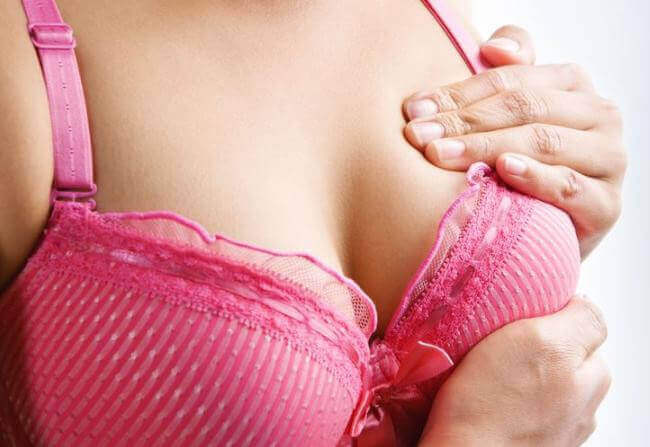Can Nipple Changes During Pregnancy and Breastfeeding Be Avoided?


Written and verified by the dermatologist Maria del Carmen Hernandez
Pregnancy and breastfeeding are natural and wonderful processes in a woman’s life, but they also bring with them a series of changes in the body. Among the most common alterations that pregnant women experience during this stage and that some would like to avoid are changes in the nipples.
Many women wonder if there’s a way to prevent or minimize these changes. In this article, we’ll address the nipple changes that take place during pregnancy and breastfeeding along with the various ways to avoid or mitigate their impact. Take note!

What are the changes that nipples undergo during pregnancy?
During pregnancy, a woman’s breasts prepare for breastfeeding. This involves a series of hormonal changes that affect the areolas and nipples, as detailed in an article published in the Cardiovascular Journal of Africa.
Increased coloration
The nipples become more sensitive and painful and may darken. The areolas, the pigmented area around the nipple, may also become larger and darker.
Once breastfeeding ends, the areola may return to a lighter shade but usually remains darker in color than before pregnancy.
Montgomery glands
In addition, small bumps may appear on the surface of the nipples, called Montgomery glands, which secrete a lubricating substance to protect the skin during lactation.
They may even produce a slight odor. Along with the darkening of the areola, the Baby-Friendly Hospital Initiative considers it helpful for infants to find the nipple and start breastfeeding more easily
However, once breastfeeding ends, the Montgomery glands shrink and the texture of the areola returns to its pre-pregnancy state.
Nipple changes during breastfeeding
During breastfeeding, the nipples continue to undergo changes. The act of breastfeeding can cause your nipples to become cracked or red from the constant suckling of the baby. This can cause discomfort and pain for some women. However, there are steps that can be taken to minimize these effects.
Nipple injuries
It’s important to make sure that the baby latches on correctly to the breast during breastfeeding. A proper latch can decrease the risk of nipple injury. Therefore, consulting a breastfeeding specialist or health care professional can be helpful in learning proper breastfeeding techniques to ensure proper latch-on for your baby.
Poor latch-on can cause irritation or abrasion to the areola tissue. In turn, damage to the areola can affect the comfort and success of breastfeeding.
Increased moisture
Breastfeeding can cause nipple soreness, dryness, and cracking. The areola may also become cracked, sore, or irritated due to breast milk leakage. Sometimes, moisture on the skin can lead to skin lesions and infections such as mastitis or thrush.
Therefore, it’s advisable to keep your nipples clean and dry. In addition, wearing a proper, breathable nursing bra can help keep the breasts dry and prevent moisture buildup. Specific nipple creams or ointments can also be applied after breastfeeding to keep the skin moisturized and promote healing.
Breast engorgement
The National Institute of Child Health and Human Development lists painful, firm, and swollen breasts as common symptoms of breast engorgement. This condition can flatten the nipples and make the areola feel hard, making it difficult for the baby to latch on.
To reduce symptoms, breastfeeding after massaging the breasts or hand expressing some milk first to facilitate breastfeeding is advised. In turn, frequent breastfeeding is the best way to treat and prevent engorgement.

How is it possible to mitigate nipple changes?
Although nipple changes are mostly unavoidable during pregnancy and breastfeeding, there are some approaches to minimize their impact. Some recommendations are as follows.
Skincare
Keep the skin of the nipples moisturized and protected to help minimize dryness and cracking. Using special nipple creams or ointments may be beneficial.
Supportive bras
Wearing well-fitting, comfortable nursing bras can provide additional support to the breasts and reduce discomfort during breastfeeding.
Proper breastfeeding techniques
Learning and practicing proper breastfeeding techniques, including good latch-on, can help prevent nipple injury.
Consult a specialist
If persistent nipple problems are experienced during pregnancy or breastfeeding, it’s important to seek the help of a breastfeeding specialist or health care professional.
All alterations are natural and are intended to prepare the breasts for breastfeeding and make it easier for the baby to feed. Therefore, there’s no way to completely avoid these changes, as they’re the result of the hormonal and physiological changes that occur during pregnancy.
Nipple changes are transitory
Nipple changes during pregnancy and breastfeeding are, for the most part, unavoidable, because they’re part of the natural processes of the female body. While they can’t be completely avoided, it’s possible to take steps to minimize their impact.
It’s always advisable to seek the support and guidance of health professionals if persistent problems or concerns related to the nipples occur during pregnancy and breastfeeding.
Pregnancy and breastfeeding are natural and wonderful processes in a woman’s life, but they also bring with them a series of changes in the body. Among the most common alterations that pregnant women experience during this stage and that some would like to avoid are changes in the nipples.
Many women wonder if there’s a way to prevent or minimize these changes. In this article, we’ll address the nipple changes that take place during pregnancy and breastfeeding along with the various ways to avoid or mitigate their impact. Take note!

What are the changes that nipples undergo during pregnancy?
During pregnancy, a woman’s breasts prepare for breastfeeding. This involves a series of hormonal changes that affect the areolas and nipples, as detailed in an article published in the Cardiovascular Journal of Africa.
Increased coloration
The nipples become more sensitive and painful and may darken. The areolas, the pigmented area around the nipple, may also become larger and darker.
Once breastfeeding ends, the areola may return to a lighter shade but usually remains darker in color than before pregnancy.
Montgomery glands
In addition, small bumps may appear on the surface of the nipples, called Montgomery glands, which secrete a lubricating substance to protect the skin during lactation.
They may even produce a slight odor. Along with the darkening of the areola, the Baby-Friendly Hospital Initiative considers it helpful for infants to find the nipple and start breastfeeding more easily
However, once breastfeeding ends, the Montgomery glands shrink and the texture of the areola returns to its pre-pregnancy state.
Nipple changes during breastfeeding
During breastfeeding, the nipples continue to undergo changes. The act of breastfeeding can cause your nipples to become cracked or red from the constant suckling of the baby. This can cause discomfort and pain for some women. However, there are steps that can be taken to minimize these effects.
Nipple injuries
It’s important to make sure that the baby latches on correctly to the breast during breastfeeding. A proper latch can decrease the risk of nipple injury. Therefore, consulting a breastfeeding specialist or health care professional can be helpful in learning proper breastfeeding techniques to ensure proper latch-on for your baby.
Poor latch-on can cause irritation or abrasion to the areola tissue. In turn, damage to the areola can affect the comfort and success of breastfeeding.
Increased moisture
Breastfeeding can cause nipple soreness, dryness, and cracking. The areola may also become cracked, sore, or irritated due to breast milk leakage. Sometimes, moisture on the skin can lead to skin lesions and infections such as mastitis or thrush.
Therefore, it’s advisable to keep your nipples clean and dry. In addition, wearing a proper, breathable nursing bra can help keep the breasts dry and prevent moisture buildup. Specific nipple creams or ointments can also be applied after breastfeeding to keep the skin moisturized and promote healing.
Breast engorgement
The National Institute of Child Health and Human Development lists painful, firm, and swollen breasts as common symptoms of breast engorgement. This condition can flatten the nipples and make the areola feel hard, making it difficult for the baby to latch on.
To reduce symptoms, breastfeeding after massaging the breasts or hand expressing some milk first to facilitate breastfeeding is advised. In turn, frequent breastfeeding is the best way to treat and prevent engorgement.

How is it possible to mitigate nipple changes?
Although nipple changes are mostly unavoidable during pregnancy and breastfeeding, there are some approaches to minimize their impact. Some recommendations are as follows.
Skincare
Keep the skin of the nipples moisturized and protected to help minimize dryness and cracking. Using special nipple creams or ointments may be beneficial.
Supportive bras
Wearing well-fitting, comfortable nursing bras can provide additional support to the breasts and reduce discomfort during breastfeeding.
Proper breastfeeding techniques
Learning and practicing proper breastfeeding techniques, including good latch-on, can help prevent nipple injury.
Consult a specialist
If persistent nipple problems are experienced during pregnancy or breastfeeding, it’s important to seek the help of a breastfeeding specialist or health care professional.
All alterations are natural and are intended to prepare the breasts for breastfeeding and make it easier for the baby to feed. Therefore, there’s no way to completely avoid these changes, as they’re the result of the hormonal and physiological changes that occur during pregnancy.
Nipple changes are transitory
Nipple changes during pregnancy and breastfeeding are, for the most part, unavoidable, because they’re part of the natural processes of the female body. While they can’t be completely avoided, it’s possible to take steps to minimize their impact.
It’s always advisable to seek the support and guidance of health professionals if persistent problems or concerns related to the nipples occur during pregnancy and breastfeeding.
All cited sources were thoroughly reviewed by our team to ensure their quality, reliability, currency, and validity. The bibliography of this article was considered reliable and of academic or scientific accuracy.
- Riley, C. A., Badri, T., & Hafsi, W. (2023, enero). Hyperkeratosis of the Nipple and Areola. [Actualizado el 12 de septiembre de 2022]. En: StatPearls [Internet]. Treasure Island (FL): StatPearls Publishing. Recuperado de https://www.ncbi.nlm.nih.gov/books/NBK459144/
- Soma-Pillay, P., Nelson-Piercy, C., Tolppanen, H., & Mebazaa, A. (2016). Physiological changes in pregnancy. Cardiovascular journal of Africa, 27(2), 89–94. https://www.ncbi.nlm.nih.gov/pmc/articles/PMC4928162/
- U.S. Department of Health and Human Services. (n.d.). What are some common signs of pregnancy?. Eunice Kennedy Shriver National Institute of Child Health and Human Development. https://www.nichd.nih.gov/health/topics/pregnancy/conditioninfo/signs
- World Health Organization. (2009). Baby-Friendly Hospital Initiative: Revised, Updated and Expanded for Integrated Care. Geneva: World Health Organization. Session 6, HOW MILK GETS FROM BREAST TO BABY. Recuperado de https://www.ncbi.nlm.nih.gov/books/NBK153490/
This text is provided for informational purposes only and does not replace consultation with a professional. If in doubt, consult your specialist.








